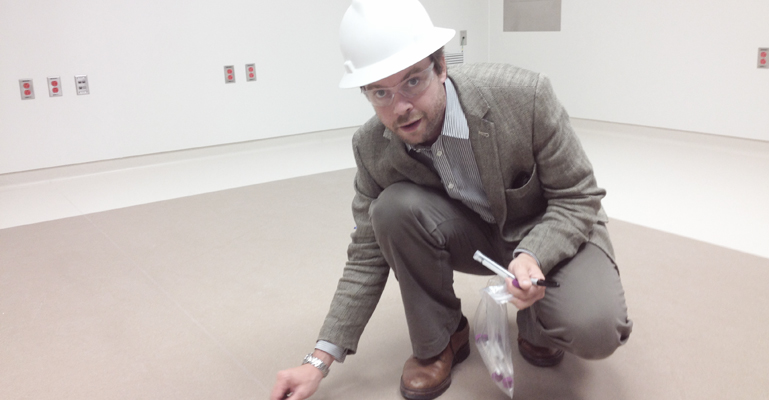
In the first few hours of a hospital stay, the microbes living on the walls and other surfaces of the hospital try to overthrow your skin microbiome. Then all hell breaks loose. Within 24 hours—and possibly as little as seven—your microbes rise up to beat back the invaders. Before the germ clouds settle, your microbiome has invaded the room.
At least, that seems to be the standard way of things, according to a new study in Science Translational Medicine. For the study, researchers at the University of Chicago, led by microbiologist Jack Gilbert, meticulously tracked the microbial comings and goings of a new hospital over the course of a year. They started from before the hospital opened and kept researching past when it was full of patients. The researchers set out to understand microbial dynamics so they can one day tweak them. Gilbert envisions future probiotics—not pills or lotions, but surface sprays and wall treatments—that can bulk up beneficial bacteria capable of ejecting deadly pathogens and even prime helpful immune defenses in patients.
-
Center for Care and Discovery, The University of Chicago's Center for Care and Discovery opened on February 23, 2013.The University of Chicago Medicine
-
Nursing station: the researchers gathered samples from each unit's nursing staff by swabbing their hands, gloves, and shoes, as well as nursing station countertops, chairs, computers, land lines, and cell phones.The University of Chicago Medicine
-
This is study author Jack Gilbert, PhD, director of the Microbiome Center and professor of surgery at the University of Chicago and group leader in Microbial Ecology at Argonne National Laboratory.The University of Chicago Medicine
-
Dr. Jack Gilbert collects a sample from the floor of a future operating room.
“We know that generally cleanliness or hygiene in the hospital is a good thing,” Gilbert told Ars. “But what if we’re missing a trick? What if there are actually changes in the hospital microbiome environment which could actually be beneficial?”
It sounds a bit farfetched, he acknowledges, but “it’s not something that’s too far away from reality.”
Data from the new study, as well as other studies, hint that diverse, thriving microbial communities living indoors may promote health. It’s still early—we need a lot more data, Gilbert admits—but “maybe we need to rethink our strategy around the hospital cleaning procedures.”
In the new study, Gilbert and his team started chipping away at the big question. They swiped and surveyed microbes from the nooks and crannies of patients and staff. They similarly swabbed hospital fixtures, starting two months before the hospital opened in February 23, 2013. Surface samples came from two nurses’ stations and 10 patient rooms, split evenly across the surgical floor of the hospital and the floor with hematology and oncology departments. The researchers wiped bed rails, walls, floors, chairs, phones, faucets, air filters, computer mice, shoes, and countertops. They also kept track of conditions in the hospital, such as temperature, humidity, and lighting. All the rooms were cleaned daily with an ammonium solution and then with bleach between patients. A year later, they had 6,523 microbial-laden samples to sequence and analyze.
Invisible conquerors
Before the hospital opened, the microbiomes of building materials, marked by Acinetobacter and Pseudomonas, quietly roamed the halls, the researchers found. Once opened, a tidal wave of human skin microbes swept in, completely overturning the communities. Skin-associated groups—including Corynebacterium, Staphylococcus, and Streptococcus—reigned for the rest of the study.
In terms of people and their microbes, the researchers found some unsurprising links: the microbes on the hands of staff most closely resembled those on their pagers and phones, for instance. Likewise, microbes on bed rails mirrored those on patients’ hands.
But there were some surprises, too—most notably, the microbial drama that seemed to unfurl when a patient settled into a hospital room. In the first few hours, the microbes from the room’s surfaces quickly encroached on the patient’s skin, researchers found. But, by 24 hours, the proverbial tables turned: the patient’s microbes seemed to regain their footing and begin pouring in and taking over the room. The longer the stay, the more the two microbial camps melded together and marched toward an equilibrium point.
The data highlights “this idea that you’re constantly, constantly exchanging and interacting with the microbial world around you,” Gilbert stresses. The data further hints that, when nurses visit a patient, they can drop off microbes from their clothes that then cause another wiggle in the microbial balance. (Because nurses often wear masks and gloves, their microbiomes didn’t seem as affected by the exchange, Gilbert said). But for the patient camped out in their room, at a certain point, they’re just exchanging their own microbes back and forth with themselves, Gilbert explains.
Warmer and more humid conditions seemed capable of disturbing microbial balance, the researchers found. In warmer conditions, the microbes of patients and their rooms became less similar. Whereas in humid conditions, they became more similar. But, when the researchers looked at the effects of the types of treatments the patients were getting—oral antibiotics, chemotherapy, surgery, etc.—they didn’t see significant effects. The one exception was the use of topical antibiotics, which did squash microbial populations on the skin.
Together, the data offer some interesting glimpses of the hospital’s microbial world. But the results aren’t enough to make any clinical guidelines yet, Gilbert said. For that, more research is already in the works. He and his colleagues are developing a project that will allow them to track the daily movements of microbes in a hospital—which will take even more sampling and genetic analyses. They’re also curious how microbes interact with hospital surfaces and whether we could manipulate the surfaces themselves to harbor the most favorable communities.
And, of course, they’ll want to watch their young hospital’s microbiome grow up. “We have a baseline now,” he said. “We now want to follow it up every five years and determine how it evolves.”
STM, 2017. DOI: 10.1126/scitranslmed.aah6500 (About DOIs).
reader comments
44